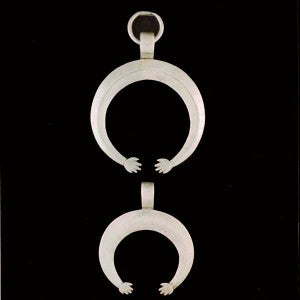Scholars have defined the distinct eras of Navajo Jewelry production by the techniques used and the style of jewelry created by the Navajo silversmiths. First Phase Navajo jewelry has been defined as that which was produced between 1850 and 1910.

This is a group of First Phase Navajo Conchas collected by the Smithsonian Museum. Please notice the enclosed domed concha at the upper left. This is a very rare specimen for this period.
During this period of time the Navajo smiths were trading with the Plains tribes, the Mexicans to the south and acquiring turquoise from the Pueblos of New Mexico. The Navajo's would trade fruit, textiles and animals for iron, copper, silver and brass. This trade also exposed the silversmiths to the metal forms and designs that they would incorporate into their metal jewelry. The naja, concha, pomegranate (squash blossom), cross, canteen and bridle decorations were not invented by the Navajo, rather they observed these forms and designs while trading with the Plains and Mexican people.

A couple of relatively plain Navajo najas from the Smithsonian Collection.
Tools for working the silver were either acquired through trade or constructed by the silversmith himself. The silversmith's ingenuity drove them to create forges from sticks and mud, crucibles from clay, and even a bellows could be created with animal skin and wood. Chisels and stamps were created out of railroad spikes or nails and an anvil might have been created from scap iron. All of these tools would allow them to master the basic techniques of embellishing their jewelry. The Navajo silversmiths also developed the tufa-casting technique during this phase. Tufa-castingenabled them to produce a much wider range of designs and shapes then was possible before.

Modern Tufa Cast Buckle by Harrison Bitsui
During this first period of Navajo jewelry the smiths established their distinctive design aesthetic. Making up this aesthetic were the use of turquoise and coral, the incorporation of four decorative elements representing the cardinal directions or using double or paired elements which related to the relationship of the earth and sky. Designs also incorporated the use of six elements which such as a row of six turquoise stones which refer to the six inner forms of the sacred mountains Jewelry created in this period is the most collectable for their simple and yet powerful design aesthetics.
New techniques and tools became available to the Navajo silversmiths early in the 1900's and were responsible for ushering in the beginning of the Second Period of Navajo silver jewelry.
